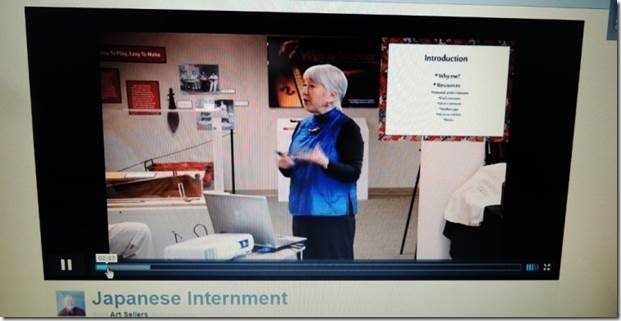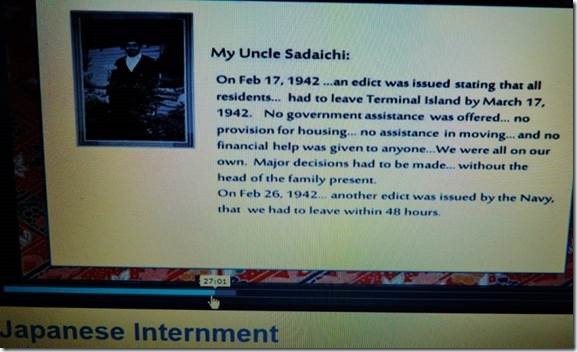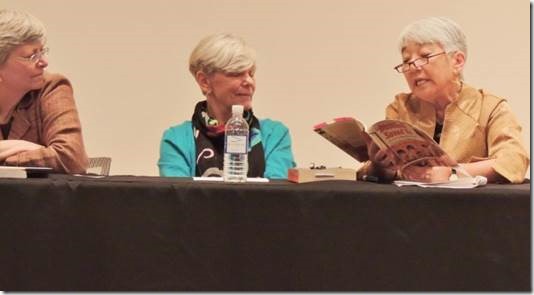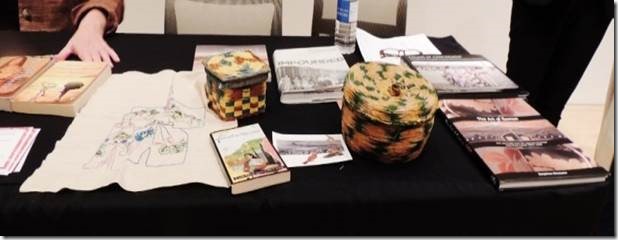Roanoke, VA 24012
"The idea is that the city that opens the same book – closes it in greater harmony."
~Mary McGrory,
"The Washington Post"
The Internment of Japanese American Citizens during World War 2 was the setting for the books chosen by Roanoke Valley Reads.
Ru
You all met have met my friend Jane Field at least twice; once when she and her husband came to London, visited DoraMac and Jane and I went out and about for a day. And just recently in the story of the City Library’s reopening. Well this email is about Jane too.
Jane was born in Chicago. Her mother and father were born in California. Both of her parents while in their teens, along with their families, were sent to Japanese American Internment Camps during World War 2. As part of Roanoke Valley Reads, Jane was asked to speak about her family’s experiences during the war as well as join a follow-up panel presentation. After agreeing Jane, being a wonderful librarian/teacher, started doing research, because though she knew her parents had been interned, they’d not shared the stories while Jane was growing up. However, not long after her Jane’s father’s death, and while her mother’s memory was still good, Jane’s mother wrote about her own and her husband’s family’s history. Jane’s uncle also wrote a family history; all three together totaling over 1500 pages of stories and documents. Jane correlated her family’s experiences plus information from exhibits she’d seen at museums with the events in the three Roanoke Valley Reads books; Adult/Young Adult book : Hotel on the Corner of Bitter and Sweet by Jamie Ford; picture book : the bracelet written by Yoshiko Uchida and illustrated by Joanna Yardley; and Young Adult book : Weedflower by Cynthia Kadohata http://roanokevalleyreads.com/youth-read Though all of the titles chosen were fiction, Jane’s family had shared similar experiences.
Jane did an amazing job! Her presentation was eye-opening, personal, educational and very moving. . http://vimeo.com/108886720 is the hour+ presentation. We all could have sat another hour listening to Jane! I’ve not tried to tell you what Jane said during the presentation because watching the video is so much better than anything I could write about it.
The following photos were taken from my computer screen. I’d not taken my camera to the talk but thankfully it was video-taped
|
Jane told us that in many cases the adult males were taken first to help build the shelters used at the camps leaving the women and children to gather and transport family belongings as best they could. Some churches did step in to help, but not the American government. Jane brought the two small suitcases her mother had been allowed to take to the internment camp. They were heartbreakingly small. Many families burned family photos and personal documents rather than leave them behind and to be destroyed by looters or taken as “evidence” by the American government. |
Randal and I also attended the Roanoke Valley Reads panel discussion about the Japanese/American internment camps held at the Taubman Museum of Art.
“A panel presentation and discussion of themes in Hotel on the Corner of Bitter and Sweet. Panelists are Jane Field, whose parents were in an internment camp, Mary Atwell, retired history and criminal justice professor, and Susan Mead, professor of sociology.” Susan Mead spoke about our fear of those different from ourselves and also how long it took for the study of American history to mention the Japanese/American internment camps. Mary Atwell spoke about the Supreme Court Cases related to the internment camps. “
|
Susan Mead, Mary Atwell, and Jane who taught us all about the Art of the Gaman “to bear the seemingly unbearable with dignity and patience.” |
|
Artifacts from Jane’s family and books connected to the Art of the Gaman. “We are at our best as a nation when trying times lead us to redemption, growth and inspiration. Stories from such times—and the lessons they teach—play a key role in the Smithsonian’s mission to tell the American story. A case in point: “The Art of Gaman: Arts and Crafts from the Japanese American Internment Camps, 1942-1946,” on view through January 30, 2011, at the Renwick Gallery, part of the Smithsonian American Art Museum. During World War II, our government sent 120,000 ethnic Japanese living in the western United States to internment camps; more than two-thirds were American citizens by birth. Most were given barely a week’s notice to settle their affairs and report to camp, with possessions limited to what they could carry. They lived in hastily constructed barracks in remote and often barren locations, while several thousand of them were drafted or enlisted to serve in the U.S. armed forces. Despite the harsh conditions, many internees found the will to make beautiful objects—chairs, dolls, tools—from scrap and indigenous materials. The word gaman means to bear the seemingly unbearable with dignity and patience. These works help us understand art’s healing power as they remind us of tragically misguided actions by our government in the heat of war.” Read more: http://www.smithsonianmag.com/ http://www.smithsonianmag.com/ is a short video about the Art of Gaman |
"Most of the 110,000 persons removed for reasons of ‘national security’ were school-age children, infants and young adults not yet of voting age."
– "Years of Infamy", Michi Weglyn
"In the detention centers, families lived in substandard housing, had inadequate nutrition and health care, and had their livelihoods destroyed: many continued to suffer psychologically long after their release"
– "Personal Justice Denied: Report of the Commission on Wartime Relocation and Internment of Civilians"
Almost 50 years later, through the efforts of leaders and advocates of the Japanese American community, Congress passed the Civil Liberties Act of 1988. Popularly known as the Japanese American Redress Bill, this act acknowledged that "a grave injustice was done" and mandated Congress to pay each victim of internment $20,000 in reparations.
The reparations were sent with a signed apology from the President of the United States on behalf of the American people. The period for reparations ended in August of 1998.
Despite this redress, the mental and physical health impacts of the trauma of the internment experience continue to affect tens of thousands of Japanese Americans. Health studies have shown a 2 times greater incidence of heart disease and premature death among former internees, compared to noninterned Japanese Americans.




